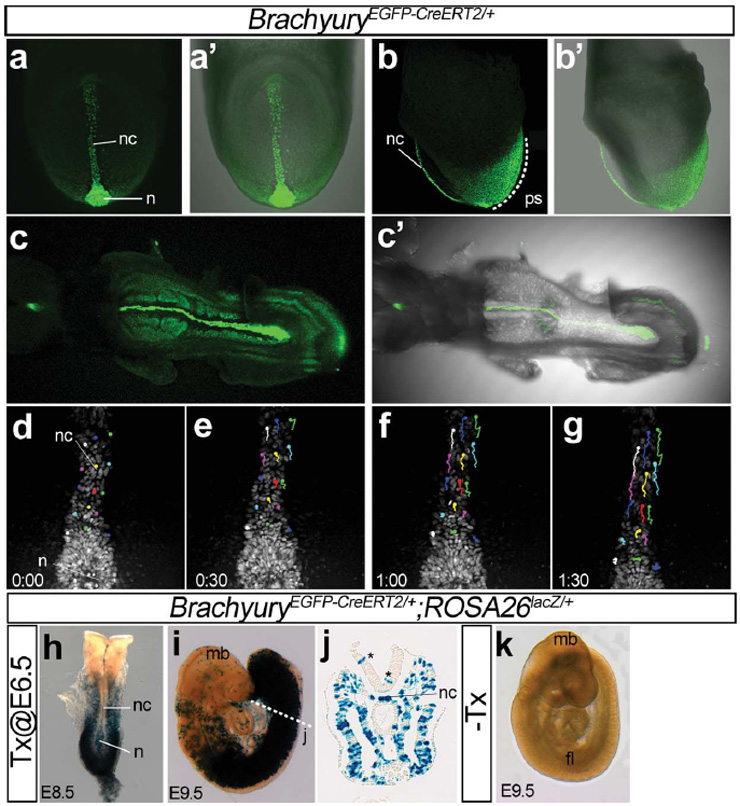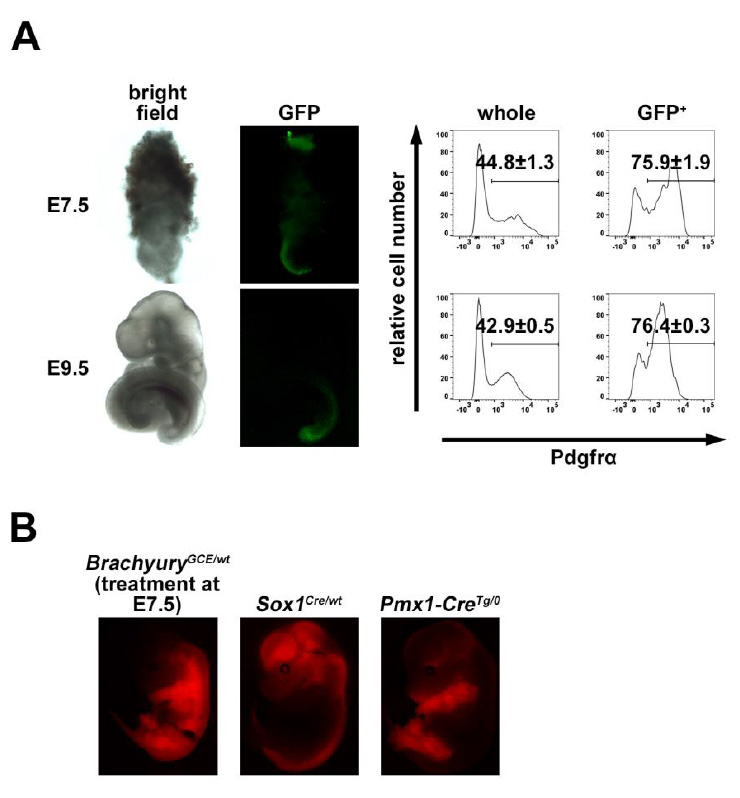|
|
|
Allele Information
|
|
Allele:
|
Ttm1(cre/ERT2)Hssk
brachyury, T-box transcription factor T;
targeted mutation 1, Hiroshi Sasaki
|
Driver: T
Type: Targeted
(Inducible, Recombinase)
|
|
|
Inducer:
|
tamoxifen
|
|
Synonym:
|
TEGFP, TnEGFP-CreERT2
|
|
Molecular description:
|
Recombineering of the BAC clone RP23-99E8 containing the T (brachyury) locus generated a targeting vector designed to replace the stop codon of T and introduce sequences encoding the ERAV 2A peptide, a human histone H2B/EGFP fusion protein (protein is expressed in the cell nucleus), the Thosea asigna virus 2A peptide and cre/ERT2 fusion protein. A self-excising ACN cassette (containing the neo resistance marker) was also included. The vector was electroporated into ES cells for homologous recombination. Chimeras were generated from 3 independent clones (36, 41, and 44) and were bred to C57BL/6J females, with the ACN cassette self-excising during passage through the germline. The line derived from #41 was analyzed further.
|
|
Find mice (IMSR):
|
Mouse Strains:
0 strains available
Cell Lines:
0 lines available
|
|
Additional Tissues:
|
Ttm1(cre/ERT2)Hssk activity also observed in:
mesenchyme,
nervous system,
reproductive system
|
|
|
Tissue Information
|
|
Embryo-other
|
Other recombinase alleles with activity in Embryo-other tissues:
 7630403G23RikTg(Th-cre)1Tmd
7630403G23RikTg(Th-cre)1Tmd,
Acantm1(cre/ERT2)Crm,
Alpltm1(cre)Nagy,
Atoh8tm1(EGFP/cre)Gasa,
Aurkbtm1.1(cre/ERT2)Deli,
Bmpr1bTg(ACTB-FLP)4917Dym,
Calb2tm1(cre)Zjh,
Cdh5em1(nigri)Bzsh,
Cfap126tm1.1(icre)Heli,
Chrna7tm2.1(cre)Swr,
Cldn6tm1(cre/ERT2)Dam,
Ddx4em1(icre)Jobo,
E2f1Tg(Wnt1-cre)2Sor,
Edil3Tg(Sox2-cre)1Amc,
Emx1tm1(cre)Krj,
En1tm2(cre)Wrst,
Eomestm4.1(icre)Rob,
Esrrbtm1(cre)Yba,
Etv5tm1(cre/ERT2)Brst,
Fgf16tm1.1(cre)Sms,
Fgf18tm2.2(cre/ERT2)Dor,
Flt4tm2.1(cre/ERT2)Sgo,
Foxa2tm1(cre/ERT2)Hssk,
Foxa2tm1(cre)Heli,
Foxa2tm2.1(cre/Esr1*)Moon,
Foxa2tm3.1(icre)Heli,
Foxd1tm1(GFP/cre)Amc,
Foxg1tm1(cre)Skm,
Gad2tm2(cre)Zjh,
Gli1tm3(cre/ERT2)Alj,
Golm1tm2(EGFP/cre/ERT2)Wtsi,
Grhl3tm1(cre)Cgh,
Gt(ROSA)26Sortm1.1(rtTA,tetO-cre)Bkmn,
Gt(ROSA)26Sortm1(FLP1)Dym,
Gt(ROSA)26Sortm2(cre/ERT2)Brn,
Gt(ROSA)26Sortm3(phiC31*)Sor,
Gt(ROSA)26Sortm5(phiC31)Sor,
H2az2Tg(Wnt1-cre)11Rth,
HhatTg(TFAP2A-cre)1Will,
Hlfem2(cre/ERT2)Suda,
Hoxa11em1(cre/ERT2)Dmwe,
Hoxa13tm1.1(cre)Mlkn,
Hoxa3tm1(cre)Moon,
Hoxc8tm2.1(cre)Mrc,
Hprt1tm10(Ple162-EGFP/cre)Ems,
Hprt1tm1(CAG-cre)Mnn,
Hprt1tm364a(CAG-icre/ERT2)Ems,
Igs2tm2(Smarcd3-cre/ERT2)Bbr,
Kdrtm1(cre)Sato,
Krt19tm1(cre)Mmt,
Lhx1tm1.1(icre)Rob,
Lmx1btm2(cre/ERT2)Rjo,
Ltftm1(cre)Stw,
Mapttm1(cre)Nagy,
Megf6em3(cre)Zzhg,
Meis1tm3.1(cre/ERT2)Mtor,
Meox2tm1(cre)Sor,
Mesp1tm2(cre)Ysa,
Mnx1tm4(cre)Tmj,
Myf5tm1.1(cre)Mrc,
Myf5tm1(cre/Esr1*)Trdo,
Myf5tm1(cre)Mrc,
Myf5tm3(cre)Sor,
Myocdtm1(cre)Dzw,
Myod1tm1(cre)Mrc,
Nfatc1em4(cre/ERT2)Bzsh,
Nkx1-2tm2296.1(cre/ERT2)Arte,
Nkx2-5tm1(cre)Rjs,
Notch1tm3(cre)Rko,
Oprk1tm1.1(cre)Sros,
Osr1tm1(EGFP/cre/ERT2)Amc,
Osr2tm2(cre)Jian,
Pax3tm1(cre)Joe,
Pax7tm1(cre)Mrc,
Pax9tm1.1(cre)Sbam,
Pbx3tm1(EGFP/cre/ERT2)Wtsi,
Pdgfctm2.1(cre/ERT2)Hdin,
Pdgfratm1.1(EGFP/cre/ERT2)Hyma,
Pdgfratm1.1(flpo)Leol,
Piezo1em2(cre/ERT2)Smoc,
Plxnd1tm2(EGFP/cre/ERT2)Wtsi,
Pou4f1tm1.1(cre)Tcba,
Pou4f2tm1.1(cre)Tcba,
Prdm1tm3(icre)Rob,
Prdm1tm5.1(cre/ERT2)Rob,
Psmb11tm1.1(icre)Yout,
Rbpmsem1(cre/ERT2)Yzhe,
Runx1tm1(cre/Esr1*)Ims,
Runx1tm2.1(cre/Esr1*)Ims,
Sall4tm1.1(EGFP/cre/ERT2)Ykawa,
Shhtm1(EGFP/cre)Cjt,
Shroom3Gt(ROSA53)Sor,
Sox17tm2.1(icre)Heli,
Sox17tm4.1(icre/ERT2)Heli,
Sox1tm1(cre)Take,
Taglntm2(cre)Yec,
Tbx3tm4(cre/Esr1*)Moon,
Tfap2atm1(cre)Moon,
Tg(Acan-cre/ERT2,-luc)1Gbg,
Tg(ACTA1-cre)79Jme,
Tg(ACTB-cre)#Bzsh,
Tg(ACTFLPe)9205Dym,
Tg(Acvrl1-cre)B1Spo,
Tg(Acvrl1-cre)L1Spo,
Tg(Adipoq-cre)1Evdr,
Tg(Alx4-cre/ERT2)1Bky,
Tg(CAG-cre)13Miya,
Tg(CAG-cre)1Nagy,
Tg(CAG-cre)2Osb,
Tg(CAG-cre/Esr1*)1Lbe,
Tg(CAG-cre/Esr1*)5Amc,
Tg(CAG-dre)1Afst,
Tg(CAG-flpo)1Afst,
Tg(Camk2a-cre)1Nobs,
Tg(Ccr2-cre/ERT2)12Kuan,
Tg(Cdh5-cre/ERT2)CIVE23Mlia,
Tg(Cdx1-cre)23Kem,
Tg(CDX2-cre)101Erf,
Tg(Cdx2-cre/ERT)#Mllo,
Tg(Cdx2-cre)R337Npln,
Tg(Cga-icre)961Sac,
Tg(CMV-cre)1And,
Tg(CMV-cre)1Cgn,
Tg(Col10a1-cre)1465Vdm,
Tg(Col10a1-cre)1466Vdm,
Tg(Col11a2-cre)4Nhzi,
Tg(Col1a1-cre/ERT2)1Crm,
Tg(Col1a2-cre)23Angl,
Tg(Col2a1-cre)10Amc,
Tg(Col2a1-cre)15Amc,
Tg(Col2a1-cre)1Asz,
Tg(Col2a1-cre)1Bhr,
Tg(Col2a1-cre)1Rsjo,
Tg(Col2a1-cre)3Amc,
Tg(Col2a1-cre/ERT)1Flng,
Tg(Col2a1-cre/ERT)KA3Smac,
Tg(Cryaa-cre,Tyr)39Mlr,
Tg(Csf1r-cre/Esr1*)1Jwp,
Tg(Ctgf-cre)2Aibs,
Tg(Cxcl13-cre,-tdTomato)719Biat,
Tg(Cyp19a1-cre)5909Gle,
Tg(Cyp19a1-cre)5912Gle,
Tg(Cyp39a1-cre)1Aibs,
Tg(Dct-cre)1Apdn,
Tg(Ddx4-cre)1Dcas,
Tg(Dhh-cre/ERT2)1Heno,
Tg(Dll1-cre)33Dchp,
Tg(dlx5a-cre)1Mekk,
Tg(DMRT1-cre)1Svs,
Tg(EIIa-cre)C5379Lmgd,
Tg(Emx1-cre)3Ito,
Tg(Eno2-cre)39Jme,
Tg(Etv2-cre)15508Djg,
Tgfb3tm1(cre)Vk,
Tg(Fev-cre)FF9Pasq,
Tg(Fgf15-cre)1Bld,
Tg(Fgf15/Hsp68-cre)1Bld,
Tg(Foxa2*-cre)#Mku,
Tg(Foxa2/Sox9-cre,-lacZ)#Vleu,
Tg(Frzb-cre)1Tylz,
Tg(Frzb-cre)2Tylz,
Tg(Frzb-cre)3Tylz,
Tg(Fzd10-cre/Esr1*)1Chzh,
Tg(Gata1-cre)1Sho,
Tg(GATA5-cre)1Krc,
Tg(GDF6-cre/ERT2)L2Kng,
Tg(Hand2-cre)7-1Clou,
Tg(HBB-cre)12Kpe,
Tg(HBB-cre)27038Kpe,
Tg(HBB-cre)27053Kpe,
Tg(Hes7-cre)1Kag,
Tg(Hhex-cre,-GFP)1Ksz,
Tg(Hoxa1-cre)1Tlu,
Tg(Hoxa5-cre)444CLjea,
Tg(Hoxa5-cre)447BLjea,
Tg(Hoxb6-cre)A5Mku,
Tg(Hoxb6-cre)C33Mku,
Tg(Hoxb6-cre/ERT)1Smac,
Tg(Hoxb7-cre)13Amc,
Tg(Hoxb7-cre)1Rob,
Tg(Hoxb7-cre)5526Cmb,
Tg(Hoxb8-cre)1403Uze,
Tg(Hspa2-cre)1Eddy,
Tg(Htr1a-icre)1Fto,
Tg(Ins2-cre)25Mgn,
Tg(Kdr-cre)15962Brei,
Tg(Kera-cre)KC4.3Wwk,
Tg(Krt19-icre)2Hirt,
Tg(KRT5-cre)5132Jlj,
Tg(Lck-cre)548Jxm,
Tg(Leftb-cre)1Hmd,
Tg(Lefty1-cre)2Hmd,
Tg(Lefty1-cre/ERT2)8Hmd,
Tg(Lefty2-cre)21bHmd,
Tg(LPAR4-cre/ERT2,-EGFP)#Hjcho,
Tg(Ltf-cre)#Stw,
Tg(Mef2c-cre)1Blk,
Tg(mI56i-cre)6-2Clou,
Tg(Mitf-cre)7114Gsb,
Tg(MMTV-cre)4Mam,
Tg(Mpz-cre)94Imeg,
Tg(myl7.L-cre)1118Tmhn,
Tg(myl7.L-cre)1141Tmhn,
Tg(MYOD1-cre)M23Glh,
Tg(Myog-cre)1Eno,
Tg(Nes-cre)1Atp,
Tg(Nes-cre)1Wme,
Tg(Nes-cre)1Wmz,
Tg(Neurog3-cre)C1Able,
Tg(Nodal-cre)16Hmd,
Tg(Nodal-cre)1Rob,
Tg(Nodal*-cre)#Mku,
Tg(Nppa-cre)3Vmc,
Tg(Nr5a1-cre)2Klp,
Tg(Nrp2-cre,-EGFP)#Qsch,
Tg(Nrp2-cre/ERT2,-Kikume)1Qsch,
Tg(Osr1-cre)4Mrt,
Tg(Pax2-cre)10Shwl,
Tg(Pax2-cre)1Akg,
Tg(Pax3-cre)2Joe,
Tg(Pax6-cre)1Zkoz,
Tg(Pax6-cre,GFP)1Pgr,
Tg(Pcp2-cre)1Amc,
Tg(Pcp2-cre)2Mpin,
Tg(Pf4-icre)Q3Rsko,
Tg(Pitx2-cre/Esr1*)#Hmd,
Tg(Plp1-cre/ERT2)1Ueli,
Tg(Pou3f4-cre)32Cren,
Tg(Prdm1-cre)1Masu,
Tg(Prrx1-cre)1Cjt,
Tg(Prrx1-cre/ERT2)1Mlgn,
Tg(Prrx1-cre/ERT2,-EGFP)1Smkm,
Tg(Prrx1-mTFP1,-cre/ERT2)1Etnka,
Tg(Rarb-cre)1Bhr,
Tg(Rarb-cre)1Mrc,
Tg(Rr141-cre)1Ksec,
Tg(Rr437-cre)#Hmd,
Tg(Rr457-cre/Esr1*)7Hmd,
Tg(rx3-icre)1Mjam,
Tg(Scx-cre)HShuk,
Tg(Sftpa1-cre)1Xya,
Tg(Six1-cre)2Kwk,
Tg(Slc17a6-icre)1Oki,
Tg(Smad7-cre)1Sjc,
Tg(Smarcd3-cre/ERT2)#Bbr,
Tg(Sox10-cre)1Wdr,
Tg(Sox10-cre)507Mcln,
Tg(Sox2-flpo)#Mhem,
Tg(Tagln-cre)1Her,
Tg(Tal1-cre/ERT)1Jrg,
Tg(Tal1-cre/ERT)42-056Jrg,
Tg(Tbx18-icre)3Fech,
Tg(Tbx6-cre)#Rsam,
Tg(Tcfap2a-cre)1Will,
Tg(T-cre)1Gos,
Tg(T-cre)1Lwd,
Tg(Tek-cre)12Flv,
Tg(Tek-cre)1Rwng,
Tg(Tek-cre)5326Sato,
Tg(Tek-cre)#Xya,
Tg(Thy1-cre)1Vln,
Tg(Tie1-cre)9Ref,
Tg(Tlx2-cre)#Ymor,
Tg(Tyr-cre)1Gfk,
Tg(Tyr-cre)1Lru,
Tg(Tyr-cre/ERT2)1Lru,
Tg(Tyr-cre)#Lru,
Tg(Tyrp1-cre)1Ipc,
Tg(Vav1-cre)8Cgp,
Tg(Wnt11-cre/ERT2)1Jwng,
Tg(WT1-cre)1Asc,
Tg(WT1-cre)AG11Dbdr,
Tg(Zp3-cre)3Mrt,
Tmem163Tg(ACTB-cre)2Mrt,
Tppp3tm1.1(icre/ERT2)Fan,
Twist2tm1.1(cre)Dor,
Twist2tm1(cre)Dor,
Wnt6tm1(cre)Mrc,
Wt1tm1(EGFP/cre)Wtp
(less)
|
|
|
Images
|
Drag images to compare to others or to data in the table below. Drag corners to resize images for more detail.
Reset Images
J:194054
Fig. 4
 J:270956
Fig. S4
J:270956
Fig. S4

|
|
Recombinase Activity
|
Click heading to re-sort table.

|
|
References
|
|
